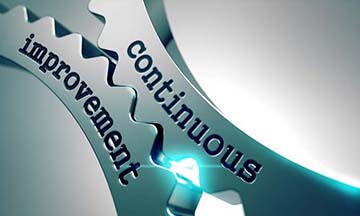
Be it workplace safety or in any field, having a continuous improvement plan is crucial to ensure well-calibrated progress. Drive for continuous improvement is one of the major reasons for the success of top businesses. Continuous improvement is an essential part of a good health and safety culture. So, do you have a continuous improvement plan?
Work is demanding. In the high-risk industries we specialize in, that work can demand more than just an employee’s effort – it can oftentimes demand their bodies, as well. Back pain, collision injuries, falls, lung poisoning, chemical exposures, burns, bruises, and blemishes alike; employees place their bodies under tremendous tension with their lives at risk on a daily basis.
The realities of high-risk industries can be grim for on-the-ground employees – but they do not have to be. It is the responsibility of employers to take this burden of danger off of the employee’s shoulders, by preventing and mitigating any and all risks they may encounter using effective safety programs.
Far too often, however, employers will take a one-and-done approach to the implementation of these programs. Then, when metrics plateau and better safety results are demanded – the scramble for improvement begins, oftentimes to no avail. There is a far better way.
Continuous Improvement
Safety programs demand more than just set up, and employees deserve more. Simplified metrics like fatality and injury rates cannot be the only baseline for determining a safety program’s effectiveness. Even if a safety program successfully lowers injury rates, the benefits of continuous improvement procedures are far too large to be considered anything other than crucial.
A safety program that is continuously improving will seep its benefits throughout all departments of an organization. Meaning that your safety programs won’t just stop at injury rates and fatalities; it will quickly branch into the areas of productivity, morale, procedural improvements, comfort, communications, and more.
Continuous Improvement Relies on Employees
Continuous improvement doesn’t just rely on injury and fatality rates to determine success. To continually improve a safety program, direct feedback from employees becomes vital. With this focused feedback, two incredibly beneficial avenues open:
One, this feedback directly improves safety processes by placing the power of improvement in the hands of employees and management simultaneously. Dangers and procedural flaws are noticed most effectively by on-the-ground employees – they are the ones encountering these risks and procedural roadblocks on a daily basis, not the employers. Giving them direct capabilities to suggest and make changes is a foundational necessity for the continual improvement of a successful safety program.
Secondly, this direct feedback opens the avenue of improving branching aspects of safety that are all linked to improvements in productivity. By utilizing this mindset for continuous improvement and extending the conversation to more humane aspects of an employee’s work-life – like comfort, engagement, and workplace morale – an organization will be poised to improve those aspects; and the rewards are palpable.
Generally, companies aiming for continuous improvement tend to perform a safety compliance review, also known as a gap analysis. This is an audit of a company’s program. It tells them where they are with regards to safety compliance and where they need to be.
When HSMS Consulting Services does your gap analysis, it becomes a strong due diligence document in the authorities’ eyes. This is largely because it will free of personal prejudices and opinion within the organization. More importantly, it shows the authorities that you are working regularly to achieve continuous improvement by:
- Identifying potential gaps in your program.
- Finding ways to fill them based on the recommendations provided by the expert consultant.
Contact Us at HSMS Consulting Services and we shall assist you further

